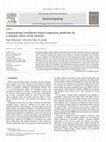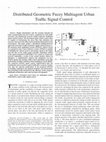Papers by Balaji Parasumanna
I would also like to thank all my colleagues in the lab for making it an ideal environment to per... more I would also like to thank all my colleagues in the lab for making it an ideal environment to perform research. My special thanks goes to Mr.Seow Hung Cheng, who took extra effort to ensure all the facilities, equipments and software are available to us at all time.

2015 IEEE Congress on Evolutionary Computation (CEC), 2015
ABSTRACT Electricity markets in countries around the world are being restructured in pursuit of e... more ABSTRACT Electricity markets in countries around the world are being restructured in pursuit of economic efficiency through competition. However, unpredictability in electricity prices and previous occurrences of market failure have indicated a need to better understand the complex interactions between the various market participants as well as to design market rules that maximizes efficiency and security. In this paper, the techniques of Agent-based Computational Economics (ACE) are employed to simulate the behavior of the GenCo participants in the National Electricity Market of Singapore (NEMS). The use of Reinforcement Learning (RL) in the agent-based modeling will be a more realistic representation of the GenCo and will bring about more accurate electricity market simulation outcomes. Actor-Critics constitute an important aspect of RL and in this paper we propose an adaptive actor-critic mapping using Particle Swarm Optimization (PSO). A simulation platform is built with the proposed model for Genco's learning and is tested in the conditions of varying vesting contract levels. Simulation results indicate that the proposed learning algorithm is able to procure higher GenCo revenue when benchmarked with existing learning algorithms.

IEEE Systems Journal, 2014
This paper proposes a new modified symbiotic evolutionary learning method (SET2) for fine-tuning ... more This paper proposes a new modified symbiotic evolutionary learning method (SET2) for fine-tuning the parameters of a type-2 fuzzy system. The paper uses a groupbased symbiotic evolutionary approach. Instead of evolving the individual rules and assigning the fitness values for each rule, the membership function parameters and the rules are evolved as individual groups. This method improves the exploration of the solution space, and optimizes the rule, base count and the most influencing input parameters in each rule which is difficult to obtain in conventional symbiotic evolutionary learning approach. The paper also proposes a method to obtain the similarity measure of the membership functions. In order to demonstrate the efficiency of the proposed learning method, it is deployed in a simulated urban traffic network to obtain the optimal signal timings in a distributed manner. The proposed SET2 signal control was tested for various traffic conditions experienced in a section of the Central Business District of Singapore. A comparison of the average time delay and speed of vehicles indicated that SET2 signal control performed significantly better than the benchmark signal controls such as GLIDE, hierarchical multiagent system, and geometric fuzzy multiagent system. The test bed also showcased the performance of the modified learning method in a distributed environment.
Innovations in Multi-Agent Systems and Applications - 1, 2010
Multi-agent systems is a subfield of Distributed Artificial Intelligence that has experienced rap... more Multi-agent systems is a subfield of Distributed Artificial Intelligence that has experienced rapid growth because of the flexibility and the intelligence available solve distributed problems. In this chapter, a brief survey of multi-agent systems has been presented. These encompass different attributes such as architecture, communication, coordination strategies, decision making and learning abilities. The goal of this chapter is to provide a quick reference to assist in the design of multi-agent systems and to highlight the merit and demerits of the existing methods.
2009 IEEE International Conference on Fuzzy Systems, 2009
Rapid advances made in vehicle technology and increased level of urbanization have caused an expo... more Rapid advances made in vehicle technology and increased level of urbanization have caused an exponential increase in road traffic congestion levels. This has necessitated the implementation of intelligent traffic responsive signal controllers capable of maintaining the saturation levels in each link thereby reducing congestion and increasing utilization of existing infrastructure. This paper presents one such distributed multi-agent architecture based on
2007 IEEE Congress on Evolutionary Computation, CEC 2007, 2007
Real-world applications are bound to have certain level of uncertainty inherent in them. Among th... more Real-world applications are bound to have certain level of uncertainty inherent in them. Among this noise is one of the most predominant factors affecting the optimization process whether it is conventional or evolutionary techniques. The evolutionary optimization techniques are found to be inherently stronger and robust to noisy environments but they are robust for lower noise levels, higher noise requires
2007 IEEE Congress on Evolutionary Computation, CEC 2007, 2007
IEEE International Conference on Fuzzy Systems, 2008
Coordination is one of the key components in distributed multi-agent systems. Establishing a coor... more Coordination is one of the key components in distributed multi-agent systems. Establishing a coordination scheme with minimum communication requirements and robustness to communication failure is a difficult task. A new multi-agent architecture based on type-2 fuzzy decision making is proposed here for achieving coordination with minimum communication. The decision making module has been designed to achieve the coordination between agents

Neurocomputing, 2009
This paper develops a hybrid model for single point short term traffic flow forecasting in an urb... more This paper develops a hybrid model for single point short term traffic flow forecasting in an urban traffic network. The hybrid model consists of two main modules: a fuzzy input fuzzy output filter (FIFO-filter) and a multi-layer feed-forward artificial neural network architecture optimized using evolution strategies (MLFN-ES). The FIFO-filter performs the data clustering operation and provides a rough forecasted prediction value based on the input data to the MLFN-ES associated with each cluster for modeling the input-output relation to provide accurate short term forecast value. The performance of the proposed model is demonstrated by predicting the traffic flow for an intersection in the central business district (CBD) area of Singapore. The hybrid model proposed in this paper gave a mean absolute percentage error (MAPE) of 8.35% on weekdays and 9.73% on weekends for the test data. A comparison analysis shows improved performance of the proposed hybrid method in short term traffic prediction over popular approaches like ARIMA and artificial neural network based systems.

IET Intelligent Transport Systems, 2010
This study presents a distributed multi-agent-based traffic signal control for optimising green t... more This study presents a distributed multi-agent-based traffic signal control for optimising green timing in an urban arterial road network to reduce the total travel time and delay experienced by vehicles. The proposed multi-agent architecture uses traffic data collected by sensors at each intersection, stored historical traffic patterns and data communicated from agents in adjacent intersections to compute green time for a phase. The parameters like weights, threshold values used in computing the green time is fine tuned by online reinforcement learning with an objective to reduce overall delay. PARAMICS software was used as a platform to simulate 29 signalised intersection at Central Business District of Singapore and test the performance of proposed multi-agent traffic signal control for different traffic scenarios. The proposed multi-agent reinforcement learning (RLA) signal control showed significant improvement in mean time delay and speed in comparison to other traffic control system like hierarchical multi-agent system (HMS), cooperative ensemble (CE) and actuated control.
Engineering Applications of Artificial Intelligence, 2011
This paper presents a multi-agent system based on type-2 fuzzy decision module for traffic signal... more This paper presents a multi-agent system based on type-2 fuzzy decision module for traffic signal control in a complex urban road network. The distributed agent architecture using type-2 fuzzy set based controller was designed for optimizing green time in a traffic signal to reduce the total delay experienced by vehicles. A section of the Central Business District of Singapore simulated

IEEE Computational Intelligence Magazine, 2010
Multi-agent system is a rapidly developing field of distributed artificial intelligence that has ... more Multi-agent system is a rapidly developing field of distributed artificial intelligence that has gained significant importance because of its ability to solve complex real-world problems. It provides a highly flexible and modular structure, which incorporates the domain expertise in the system, to achieve the optimal solution. Multiagent system also allows a problem to be divided into smaller sub-problems that require less domain expertise compared to solving the problem as a whole. In recent years, multi-agent system has gained significant attention in solving traffic signal control problems because of the advantages it offers in solving complex problems with uncertainties. In this paper, two different types of multiagent architectures that have been implemented on a simulated complex urban traffic network in Singapore for adaptive intelligent signal control are discussed. The results obtained indicate the superior performance of the multiagent signal controller in comparison to pre-timed and signal control methods which are currently in use.

2015 IEEE Congress on Evolutionary Computation (CEC), 2015
Electricity markets in countries around the world are being restructured in pursuit of economic e... more Electricity markets in countries around the world are being restructured in pursuit of economic efficiency through competition. However, unpredictability in electricity prices and previous occurrences of market failure have indicated a need to better understand the complex interactions between the various market participants as well as to design market rules that maximizes efficiency and security. In this paper, the techniques of Agent-based Computational Economics (ACE) are employed to simulate the behavior of the GenCo participants in the National Electricity Market of Singapore (NEMS). The use of Reinforcement Learning (RL) in the agent-based modeling will be a more realistic representation of the GenCo and will bring about more accurate electricity market simulation outcomes. Actor-Critics constitute an important aspect of RL and in this paper we propose an adaptive actor-critic mapping using Particle Swarm Optimization (PSO). A simulation platform is built with the proposed model for Genco's learning and is tested in the conditions of varying vesting contract levels. Simulation results indicate that the proposed learning algorithm is able to procure higher GenCo revenue when benchmarked with existing learning algorithms.

IEEE Transactions on Intelligent Transportation Systems, 2010
Rapid urbanization and the growing demand for faster transportation has led to heavy congestion i... more Rapid urbanization and the growing demand for faster transportation has led to heavy congestion in road traffic networks, necessitating the need for traffic-responsive intelligent signal control systems. The developed signal control system must be capable of determining the green time that minimizes the network-wide travel time delay based on limited information of the environment. This paper adopts a distributed multiagent-based approach to develop a traffic-responsive signal control system, i.e., the geometric fuzzy multiagent system (GFMAS), which is based on a geometric type-2 fuzzy inference system. GFMAS is capable of handling the various levels of uncertainty found in the inputs and rule base of the traffic signal controller. Simulation models of the agents designed in PARAMICS were tested on virtual road network replicating a section of the central business district in Singapore. A comprehensive analysis and comparison was performed against the existing traffic-control algorithms green link determining (GLIDE) and hierarchical multiagent system (HMS). The proposed GFMAS signal control outperformed both the benchmarks when tested for typical traffic-flow scenarios. Further tests show the superior performance of the proposed GFMAS in handling unplanned and planned incidents and obstructions. The promising results demonstrate the efficiency of the proposed multiagent architecture and scope for future development.

Uploads
Papers by Balaji Parasumanna